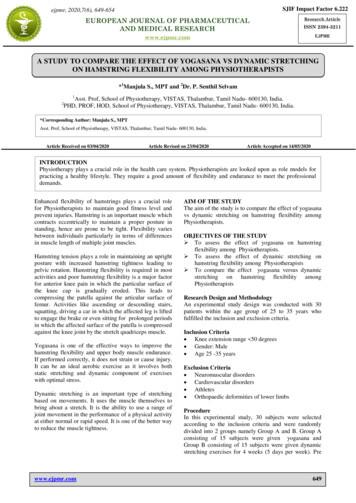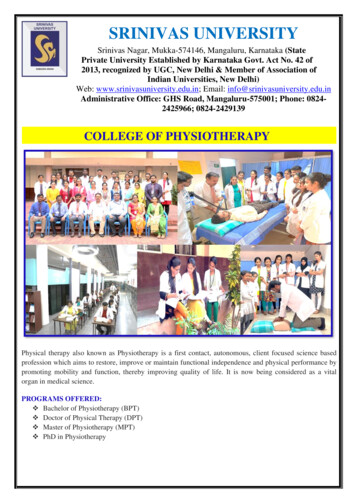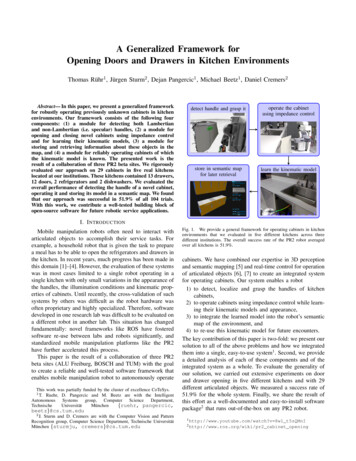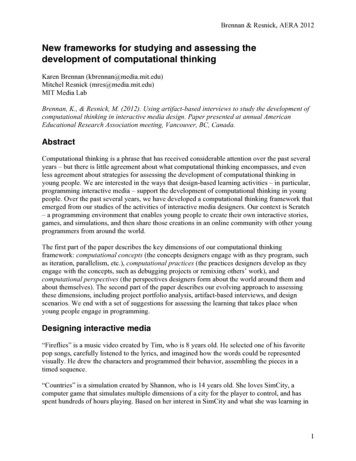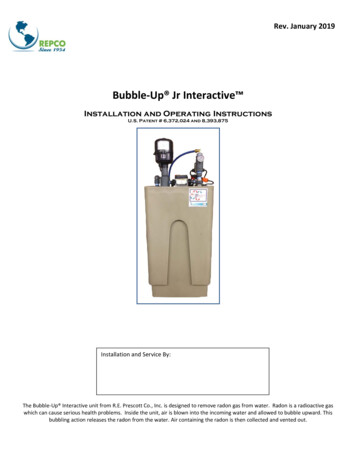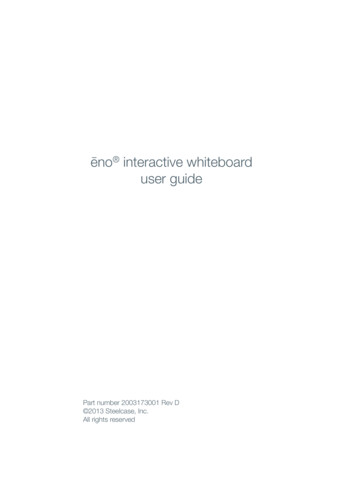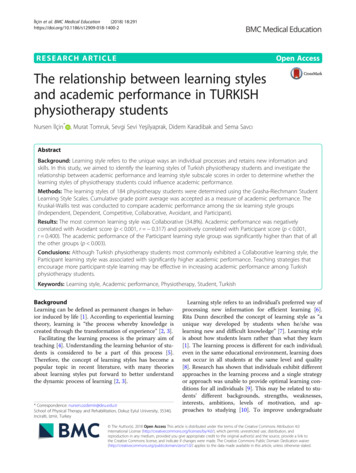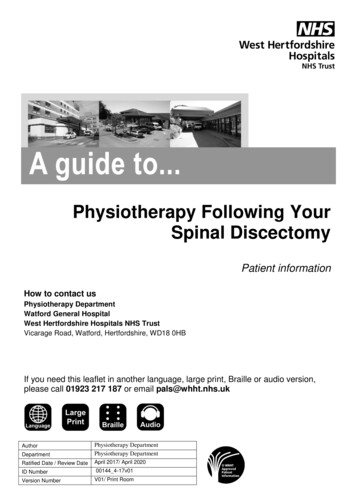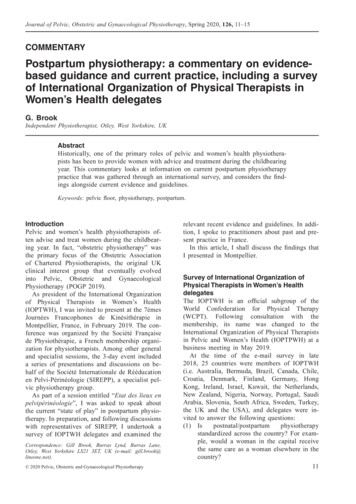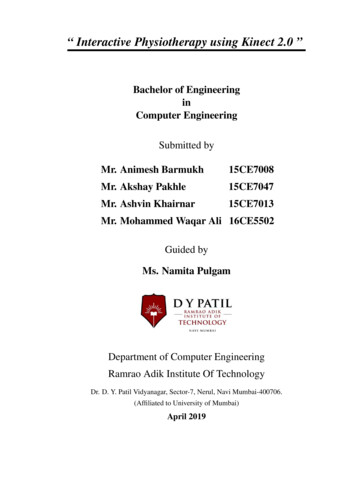
Transcription
“ Interactive Physiotherapy using Kinect 2.0 ”Bachelor of EngineeringinComputer EngineeringSubmitted byMr. Animesh Barmukh15CE7008Mr. Akshay Pakhle15CE7047Mr. Ashvin Khairnar15CE7013Mr. Mohammed Waqar Ali 16CE5502Guided byMs. Namita PulgamDepartment of Computer EngineeringRamrao Adik Institute Of TechnologyDr. D. Y. Patil Vidyanagar, Sector-7, Nerul, Navi Mumbai-400706.(Affiliated to University of Mumbai)April 2019
Interactive Physiotherapy using Kinect 2.0B.E. Project ReportSubmitted in partial fulfillment of the requirementsFor the degree ofBachelor of EngineeringinComputer EngineeringSubmitted byMr.Mr.Mr.Mr.Animesh BarmukhAkshay PakhleAshvin KhairnarMohammed Waqar Ali15CE700815CE704715CE701316CE5502Guided byMs. Namita PulgamDepartment of Computer EngineeringRamrao Adik Institute Of TechnologyDr. D. Y. Patil Vidyanagar, Sector-7, Nerul, Navi Mumbai-400706.(Affiliated to University of Mumbai)April 2019
Ramrao Adik Institute of Technology(Affiliated to the University of Mumbai)Dr. D. Y. Patil Vidyanagar, Sector-7, Nerul, Navi Mumbai-400706.CERTIFICATEThis is to certify that, the dissertation titled“ Interactive Physiotherapy using Kinect 2.0 ”is a bonafide work done byMr.Mr.Mr.Mr.Animesh BarmukhAkshay PakhleAshvin KhairnarMohammed Waqar Ali15CE700815CE704715CE701316CE5502and is submitted in the partial fulfillment of the requirement for thedegree ofBachelor of EngineeringinComputer Engineeringto theUniversity of MumbaiSupervisor(Ms. Namita Pulgam)Project Co-ordinatorHead of Department(Ms. Smita Bharne)(Dr. Leena Ragha)Principal(Dr. Ramesh Vasappanavara)
Project Report Approval for B.EThis is to certify that the project ‘B’ entitled “Interactive Physiotherapy using Kinect 2.0”is a bonafide work done by Mr. Animesh Barmukh, Mr. Akshay Pakhle, Mr. Ashvin Khairnarand Mr. Mohammed Waqar Ali under the supervision of Ms. Namita Pulgam. This dissertationhas been approved for the award of Bachelor’s Degree in Computer Engineering, Universityof Mumbai.Examiners :1. . . . . . . . . . . . . . . . . . . . . . . . . . . . . . .2. . . . . . . . . . . . . . . . . . . . . . . . . . . . . . .Supervisors :1. . . . . . . . . . . . . . . . . . . . . . . . . . . . . . .2. . . . . . . . . . . . . . . . . . . . . . . . . . . . . . .Principal :.Date : . . . /. . . /. . . . . .Place : . . . . . . . . . . . .
DeclarationWe declare that this written submission represents my ideas in my own words and whereother’s ideas or words have been included, we have adequately cited and referenced the originalsources. We also declare that I have adhered to all principles of academic honesty and integrityand have not misrepresented or fabricated or falsified any idea/data/fact/source in my submission. We understand that any violation of the above will be cause for disciplinary action by theInstitute and can also evoke penal action from the sources which have thus not been properlycited or from whom proper permission has not been taken when needed.Date : . . . /. . . /. . . . . .Mr. Animesh Barmukh15CE7008Mr. Akshay Pakhle15CE7047Mr. Ashvin Khairnar15CE7013Mr. Mohammed Waqar Ali16CE5502
AbstractPhysical therapy has become a big part of life for patients suffering from orthopedic injuries.But as time goes by, patients tend to get tired and demotivated due to repetitive and tedious exercises. So, an interactive motion detection system with the help of Kinect can be a boon to thisproblem. The use of interactive physiotherapy system makes the treatment more encouragingand entertaining. Unity3D has been used for designing the interactive environment and gamesbecause it is easy from Unity to deploy applications on different platforms. It is much easierto measure the readings and values from the sensor than using manual tools like goniometer.It also allows a therapist to customize exercises according to the specific needs and challengesof individual patients. The Microsoft Kinect sensor gives three-dimensional information aboutthe users body, recognizing skeleton and joint positions. This data in turn can be used to createinteractive games that cater to the physiotherapeutic needs of the patients. This enables an immersive and natural interaction between the user and the system. Most importantly, the recordedskeletal joint data facilitates quantitative analysis and feedback of patients body movements.i
ContentsAbstractiList of Figuresv1Introduction11.1Overview . . . . . . . . . . . . . . . . . . . . . . . . . . . . . . . . . . . . .11.2Objective . . . . . . . . . . . . . . . . . . . . . . . . . . . . . . . . . . . . .31.3Motivation . . . . . . . . . . . . . . . . . . . . . . . . . . . . . . . . . . . . .31.4Problem Definition . . . . . . . . . . . . . . . . . . . . . . . . . . . . . . . .41.5Organization of Report . . . . . . . . . . . . . . . . . . . . . . . . . . . . . .42345Literature Survey52.1Research Papers Survey . . . . . . . . . . . . . . . . . . . . . . . . . . . . . .52.2Outcome of Literature Survey . . . . . . . . . . . . . . . . . . . . . . . . . .8Project Proposal93.1Proposed Work . . . . . . . . . . . . . . . . . . . . . . . . . . . . . . . . . .93.2Hardware/Software Requirement . . . . . . . . . . . . . . . . . . . . . . . . .113.3Proposed Methodology/Techniques . . . . . . . . . . . . . . . . . . . . . . . .12Planning And Formulation154.1Schedule for Project . . . . . . . . . . . . . . . . . . . . . . . . . . . . . . . .154.2Detail Plan of Execution . . . . . . . . . . . . . . . . . . . . . . . . . . . . .15Design of System175.117Diagram and Explanation . . . . . . . . . . . . . . . . . . . . . . . . . . . . .ii
67Results And Discussion216.1Implementation . . . . . . . . . . . . . . . . . . . . . . . . . . . . . . . . . .216.2Project Outcomes . . . . . . . . . . . . . . . . . . . . . . . . . . . . . . . . .266.3Result and Analysis . . . . . . . . . . . . . . . . . . . . . . . . . . . . . . . .276.4Cost and Benefit Analysis . . . . . . . . . . . . . . . . . . . . . . . . . . . . .28Conclusion and Future Work30References31Appendices33A Weekly Progress Report33B Paper Publication34C Project Competition35Acknowledgement36iii
List of Figures1.1Digital Goniometer . . . . . . . . . . . . . . . . . . . . . . . . . . . . . . . .21.2Microsoft Kinect 2.0 . . . . . . . . . . . . . . . . . . . . . . . . . . . . . . .33.1Angles that can be Sweeped by a Normal Elbow . . . . . . . . . . . . . . . . .93.2Normal movements of a Healthy Wrist . . . . . . . . . . . . . . . . . . . . . .103.3Schematic overview of the intended setup . . . . . . . . . . . . . . . . . . . .103.4Skeletal joints tracked by Kinect 2.0 . . . . . . . . . . . . . . . . . . . . . . .133.5Calculating the Elbow Angle . . . . . . . . . . . . . . . . . . . . . . . . . . .143.6Geometrical representation of Elbow . . . . . . . . . . . . . . . . . . . . . . .144.1Project Schedule (Gantt Chart) . . . . . . . . . . . . . . . . . . . . . . . . . .155.1Use Case Diagram . . . . . . . . . . . . . . . . . . . . . . . . . . . . . . . .175.2Generalized System Architecture for Gesture Recognition [?] . . . . . . . . . .185.3System Flow Diagram . . . . . . . . . . . . . . . . . . . . . . . . . . . . . .195.4Sequence Diagram . . . . . . . . . . . . . . . . . . . . . . . . . . . . . . . .195.5State Transition Diagram . . . . . . . . . . . . . . . . . . . . . . . . . . . . .206.1Home Screen of the Game . . . . . . . . . . . . . . . . . . . . . . . . . . . .216.2Game Login Page . . . . . . . . . . . . . . . . . . . . . . . . . . . . . . . . .226.3Elbow Rehabilitation Game . . . . . . . . . . . . . . . . . . . . . . . . . . . .226.4Elbow Movements . . . . . . . . . . . . . . . . . . . . . . . . . . . . . . . .236.5Elbow Rehabilitation Game . . . . . . . . . . . . . . . . . . . . . . . . . . . .236.6Wrist Movements . . . . . . . . . . . . . . . . . . . . . . . . . . . . . . . . .246.7Wrist Rehabilitation Game . . . . . . . . . . . . . . . . . . . . . . . . . . . .246.8List of All Patients . . . . . . . . . . . . . . . . . . . . . . . . . . . . . . . .256.9Add New Patient Screen . . . . . . . . . . . . . . . . . . . . . . . . . . . . .256.10 Patient’s Feedback Page . . . . . . . . . . . . . . . . . . . . . . . . . . . . . .26iv
6.11 Graphical Analysis of Patient’s Game Data . . . . . . . . . . . . . . . . . . .276.12 Score Analysis of Patient . . . . . . . . . . . . . . . . . . . . . . . . . . . . .286.13 Patient’s Report sent to his Email . . . . . . . . . . . . . . . . . . . . . . . . .28v
Chapter 1Introduction1.1OverviewRehabilitation and physical therapy are optimal when assessment, monitoring, adherenceto the therapy program and patient engagement can be achieved. In traditional physical therapyand rehabilitation practice, different processes are involved [?]. These processes are usuallyintensive, time consuming, dependent on the expertise of the therapist and implies the collaboration of the patient who is usually asked to perform the therapy multiple times at home withno supervision [?].Injury or disease of bone, articular, or soft tissue structures of the joints can cause pain andcompromised mobility, strength, stability and functional use of the upper or lower body. [?].Traditional methods of rehabilitation is quite tedious and boring. As exercises are to be done fora long period of time, patients tends to loose interest over time because of monotonous exercisesroutines. Also, traditional physiotherapy involve use of goniometer which is a very old deviceused to measure degrees of flexion and extension of joints but it is inaccurate.The Microsoft Kinect sensor incorporates several advanced sensing hardware. Most notably, itcontains a depth sensor, a color camera, and a four-microphone array that provide full-body 3Dmotion capture, facial recognition, and voice recognition capabilities. A Kinect-based systemcan facilitate proper performance of rehabilitation exercises, increase patient accountability,allow the clinician to correct errors in exercise performance.1
Figure 1.1: Digital GoniometerFigure 1.1 shows a Digital Goniometer. A goniometer is a device that either measures an angleor moves an object along a fixed point to a specific angular position. Goniometers have manyuses and can be found in a number of industries. They measure range of motion, determinedirection, and measure an objects dimensions. Goniometers are relatively simple in design andhave been used since 1780.Goniometers are portable and are simple enough to be mass produced in a short amount of time.They are inexpensive and have many different purposes, ranging from those found in the medical industry to applications in physical science.Goniometers must be carefully labeled with respect to the angles that they measure. Goniometers are limited by the materials that they can be constructed from and must be used in conjunction with a surface medium in order to provide any significant results. Kinect can detect theangles of the elbow and other joints without the need of old and traditional goniometers. Thecameras of Kinect are much more accurate than goniometer. Kinect can detect the angles of theelbow and other joints without the need of old and traditional goniometers.As show in Figure 1.2, Microsoft Kinect 2.0 is a device which can offer innovative and excitingways to rehabilitate, making treatment more enjoyable thus increasing motivation and thereforeadherence. This is an important area for physiotherapists to develop their skills in, as technologyis beginning to thrive in the health sector and is becoming a part of therapy treatment options. Inaddition, it reduces workload by utilizing physiotherapy time effectively while still providingtherapy. The Kinect can allow the patient to interact with the system, where they performmultiple movement combinations without the need of an attached device or a controller. [?].2
Figure 1.2: Microsoft Kinect 2.01.2Objective To improve mobility and strength and to help reduce the pain that patients might sufferdue to an injury or disability. To develop interactive games using Unity3D to perform physiotherapy exercises. The system should provide updated information about the progress that will update theirrespective doctors with accurate results. Develop a profile based system to keep track of every individual’s activity.1.3MotivationExpected higher number of such cases is a challenge for physiotherapy, and therefore callsfor introduction of innovative methods for rehabilitation of patients after orthopedic injuries[?]. Consider tennis elbow, it is one of the most common orthopedic injury and a major causeof disability, mostly for sportsmen and athletes. With the development of science and technology neurological patients are faced with new possibilities of regaining psychomotor fitness.It is obvious that any additional form of improving patient’s motor functions is no substitutefor individual work with a physiotherapist, which is adapted to the individual patient’s needs.However, there is a clear need to search for new attractive and modern forms of medical rehabilitation.3
1.4Problem DefinitionThe traditional approach in medical science for physiotherapy is now been in practice sinceyears and its been very tedious for the instructor and boring for the patient. Problems likeeffective elbow rehabilitation is dependent on patients performing their exercise programs continuously. Due to the repetitive, tedious and time consuming exercise programs in traditionalphysiotherapy and outdated tools like goniometer, the patient tends to lose interest and getstired. To solve this problem, a new concept of motion detection using Kinect can be used forphysiotherapy in a way which patient may find interesting and engaging. Hence using this concept, Interactive Physiotherapy System using Microsoft can be developed to offer innovativeand exciting ways to rehabilitate, making treatment more enjoyable thus increasing motivationand therefore adherence. This is an important area for physiotherapists to develop their skillsin, as technology is beginning to thrive in the health sector and is becoming a part of therapytreatment options. In addition, it reduces workload by utilizing physiotherapy time effectivelywhile still providing therapy.1.5Organization of ReportThe rest of the report is organized as follows. Chapter 1 discusses objective and problemdefinition with respect to the existing system. The related work of this research is surveyed inChapter 2. The proposal and requirements for this research is defined in Chapter 3 followed bythe solution. Chapter 4 discusses the Planning and Formulation i.e. the schedule of the proposedwork. Design of System is included in Chapter 5. Chapter 6 discusses the results and outcomesof this project. The concluding remarks have been given in Chapter 7. And finally, the futureimprovement possibilities are discussed in Chapter 8.4
Chapter 2Literature SurveyIn clinical settings and experimental studies of muscular disorders, participants emerged ininteractive experience reduced level of pain, general distress/unpleasantness and report a desireto use Interactive approaches for medical procedures of these kind. Literature survey includesstudy of various research papers about Physiotherapy using Kinect. Following research paperswere studied based on physiotherapy and similar existing projects were compared and analyzed.2.1Research Papers SurveyA.D. Cualin, H.F. Pop, and R.F. Boian [?]. This study uses machine learning methods to analyze Kinect body gestures involved in the user interaction with exergaming systems designedfor physical rehabilitation. They propose a method to improve gesture recognition accuracyand motion analysis, by extracting from the full body motion data recorded by the Kinect sensor three important features which are relevant to physical therapy exercises: body posture,movement trajectory and range of motion. Thus, this approach has the potential to improvegesture recognition accuracy and provide user feedback on how to improve the movement performed, in particular, the movement amplitude.Jungpil Shin, (Member, IEEE) et al [?]. The paper proposes an aerial keyboard system. Asaerial keyboards are very time consuming and difficult to detect, they proposed a system thatcan use hand tapping gestures for Japanese hiragana and English characters. This will facilitatehuman machine interaction. In order to detect accurate motions and gestures the system willuse Microsoft Kinect sensors. By using this, users can interact with computers using their nontouch input system.5
Juraj Mihalov et al [?]. This paper talks about how the new motion sensing controllers bringthe gaming to a whole another level and how this technology can be used for scientific purposesand not just for entertainment. A few years ago, the world has experienced the birth of a newapproach to the game controlling. Although the classic mouse & keyboard configuration willnot be beaten so easily, The purpose of this publication is to bring a general information aboutKinect, its history and future as well as its bright and dark sides.Carlo Camporesi et al [?]. The authors proposed a new solution based on Virtual Reality technologies for improving the delivery of physical therapy and rehabilitation. Three main aspectsare addressed: 1)t he ability to allow therapists to create new exercises and therapy programsintuitively by direct demonstration, 2) automatic therapy delivery and monitoring with the useof an autonomous virtual tutor that can monitor and quantitatively assess the motions performedby the patient, and 3) networked collaborative remote therapy sessions via connected applications displaying the motions of both the therapist and the patient.Grigore Burdea et al [?]. This paper reviews the benefits brought by VR-enhanced and VRbased rehabilitation to the patient groups. Also discussed are the many challenges in integratingthis new technology into the medical care system. Virtual rehabilitation represents the provisionof therapeutic interventions locally or at a distance, using Virtual Reality hardware and simulations. Such therapy has been applied to various patient populations, including muscular-skeletaland cognitively impaired.Mateus Trombetta et al [?]. This paper proposes a serious game for post-injury rehabilitationwith six different levels of exercises. This solution allows to assist the traditional therapy andmotivate the patient to execute his/her rehabilitation program, under health professional supervision. A preliminary study shows good results in user preferences. This approach supportsfirst- and third-person point of views and virtual reality devices, like head-mounted displaysand motion sensors.J. Rosen, J.C. Perry, N. Manning, S. Burns, and B. Hannaford [?]. The aim of the research isto study the kinematics and the dynamics of the human arm during daily activities in a free andunconstrained environment as part of an on-going research involved in the design of a 7 degreeof freedom (DOF) powered exoskeleton for the upper limb. The kinematics of the upper limb6
was acquired with a motion capture system while performing a wide verity of daily activities.Utilizing a model of the human as a 7 DOF system, the equations of motion were used to calculate joint torques given the arm kinematics. During positioning tasks, higher angular velocitieswere observed in the gross manipulation joints (the shoulder and elbow) as compared to the finemanipulation joints (the wrist).E. E. Stone and M. Skubic [?]. This paper presents a method for detecting falls in the homesof older adults using the Microsoft Kinect and a two-stage fall detection system. The first stageof the detection system characterizes a person’s vertical state in individual depth image frames,and then segments on ground events from the vertical state time series obtained by tracking theperson over time. The second stage uses an ensemble of
Interactive Physiotherapy using Kinect 2.0 B.E. Project Report Submitted in partial fulfillment of t
